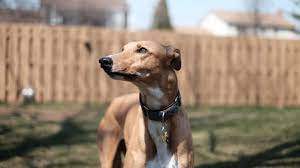The greyhound is powerful, sleek, and lean. Long thin tail, small head, long neck, deep chest, and long, strong hindquarters are some of its physical characteristics. It has a short, silky coat that is available in many different hues. It belongs to the group of hunting dogs known as sighthounds.
History
It is a veteran breed with Middle Eastern and North African roots that has gained the respect of many diverse cultures. They are the only breed of dog described in the Bible and have been mentioned by the Greeks, portrayed in Egyptian art, and lauded by a Roman poet.
Throughout the Dark Ages, it entered Europe. Because of their reputation as skilled hunters, it was against the law to own a Greyhound within ten miles of the king’s forests at the time. This was done to safeguard royal game reserves.
Scientific Name
Canis lupus familiaris
Characteristic
- Scientific Name: Canis lupus familiaris
- Origin: England
- Group: Hound Group
- Coat: Thin & glossy
- Coat Colour: Black, brindle, white, blue and red
- Height: 25-29inches
- Weight: 60-70 pounds
- Lifespan: 10-14 years
- Personality: Even-tempered, loving, kind, considerate, wise, and quiet
- Hypoallergenic: No
Are They Kid Friendly?
They are peaceful, loving, and affectionate. On the other side, most greyhounds haven’t spent much time around kids. They typically get along well with older kids under the correct conditions thanks to their even temperament.
Are They Friendly With Other Animals?
They get along nicely with other pets (including cats!) because of their friendliness. They can, however, chase small dogs and cats aggressively. They do, however, get along well with larger dogs.
The Care Your Greyhound Needs
Everyone requires love and attention. Compared to humans, animals require greater care. They are relying on us for this (human beings). So, it is our responsibility to care for our pet. To help you take care of them, this site will include information on their diet, exercise, and training.
Diet & Food
They are frequently fed rice, pasta, or bread by greyhound trainers. They receive the energy they need to function from carbohydrates. Fruits and vegetables enrich the nutrition of the greyhound.
Exercise
The kind of exercise your greyhound is capable of depends on his age and health. While a senior greyhound might not be as keen to play with other dogs, he will still enjoy a leisurely stroll with you.
Every day, they must work out for at least an hour.
- They need regular walks for both their emotional and physical well-being.
- They can work out in the backyard without any problems.
Training
If properly trained, they pick up simple orders pretty quickly, but if not, they may develop fear and become reluctant to train.
- Use encouraging reinforcement when training them.
- Teach them the fundamental rules.
- Another crucial aspect is crate training.
Grooming
Greyhound grooming is easy and just takes a few minutes per day. Greyhounds don’t have a lot of “doggy odor” and don’t need to be bathed often. Continue reading for more advice.
- You need to cut their nails about once or twice a month.
- To help reduce bacteria and prevent tartar accumulation, it is advised that people brush their teeth at least three times per week.
Health Problems
Although they are normally in good health, they are susceptible to some health issues like all breeds. Not everyone will contract any or all of these illnesses, but it’s crucial to be informed if you’re thinking about buying a dog of this breed.
Find a reputable breeder who will provide you with the health clearances for both of your puppy’s parents if you are purchasing a puppy. Health certifications attest to a dog’s having undergone testing and being declared free of a specific ailment.
Sensitivity to anesthesia
Greyhounds and other sighthounds are sensitive to several medications, including anesthesia. A Greyhound can be killed by a dose that would kill any other dog his size, most likely due to the breed’s low body fat content.
Hypothyroidism
Low amounts of the thyroid gland’s hormone are involved. Infertility could be a minor illness symptom. Obesity, mental dullness, lethargy, drooping eyelids, low levels, and irregular heat cycles are more overt symptoms.
Osteosarcoma
Osteosarcoma is a severe bone cancer that typically affects huge and enormous breeds of animals. Lameness is the initial indication of osteosarcoma, but x-rays are required to determine whether cancer is to blame.
List of Mixed Breed
- Grey Doberhound
- Greyhound Shepherd
- Greyador
- Irish Wolf Greyhound
- Saluki Greyhound
- Greybull Pit
Running Speed
It’s hardly surprising that their legs can propel them at speeds of up to 45 mph given that they are a high-energy breed.
From Where You Can Adopt or Buy Greyhound?
Greyhound adoption is significantly less expensive than buying one from a breeder. It can cost $300 to adopt. On the other hand, purchasing Greyhounds from breeders can be very expensive. Depending on the breed, they often cost between $1,000 and $4,000.
Puppies
The size of this breed’s litters can vary greatly. A litter can have anything between one and twelve puppies, with an average of eight.
Price
The cost of a Greyhound puppy ranges from $1,000 to $4,000.
Puppies from rare breeds or with show quality could cost a lot more. racing retired Many organizations rescue and rehome greyhounds.
Overview
Greyhounds are intelligent, collected, kind, tranquil, and affectionate with both kids and adults. They are also renowned for their impulsiveness and curiosity.They are the only type of dog that the Bible directly mentions. The second-fastest animal in the world is the greyhound. The cheetah is the only mammal that is faster. Greyhounds run in the air for seventy-five percent of their time.


















